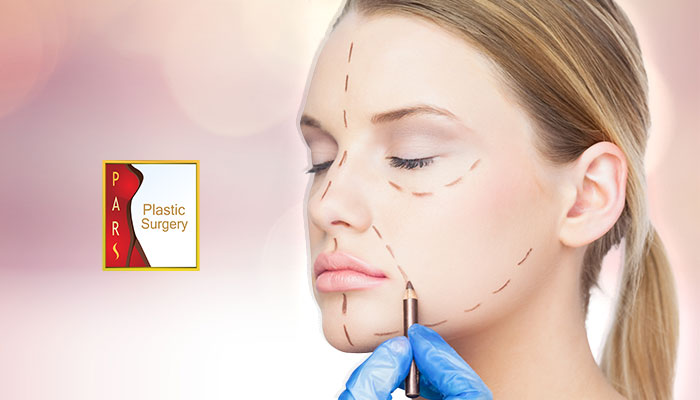
A facelift, also called rhytidectomy, is a very common procedure to effectively remove the wrinkles and sagging skin that appear as a consequence of the aging process. This type of cosmetic surgery reshapes the lower third of the face and improves the signs of aging in the face and even in the neck by removing excess skin, tightening deep tissues and muscles, or re-draping the face and neck’s skin.
Signs of aging usually include: saggy skin in the middle of the face, deep wrinkles under the eyes, deep wrinkles that extend from the nose to the mouth, loss of fat tissue in the cheeks, and visible jowls due to the sagging skin under the chin (this can occur even in people at their ideal weight; when the skin loses its tone, it creates the appearance of a double chin). The loss of youthful contours in the face can be due to a variety of factors, including inheritance, gravity, environmental conditions, and stress.
To achieve the best results, this procedure is usually combined with additional procedures addressing the forehead and brows (brow or forehead lift) and eyes (eyelid surgery). Statistics from the American Society of Plastic Surgery say it was one of the most popular aesthetic procedures during 2011, and this procedure is increasingly popular among both men and women.
This surgery cannot change the essential appearance of the face, and it can only recover a youthful appearance temporarily, but although there are non-surgical methods to achieve a more youthful appearance, none of them can produce the same results.
Who is an ideal candidate for a facelift?
The ideal candidates for this procedure are people with evident signs of aging in their face and neck but who still have elasticity in their skin. Age is not a limiting aspect; however, most patients that can benefit from this surgery are between 40 and 70 years old (though younger and older people can undergo a facelift too).
The patient should be healthy (not having medical conditions that may delay the healing process) and be conscious of the scope of the surgery; it can create a fresher and younger appearance, but the face will not completely be without signs of aging.
Usually, patients who undergo this surgery feel that their facial appearance is too old compared to their spirit. They believe that their appearance is causing problems in their social life and career. Some other patients consider that typical things like the aging process and sun exposure, among other factors, have caused changes in their face, and they don’t desire to look that way.
What are the advantages of facelift surgery?
– This procedure can improve different parts of the face at the same time.
– It can achieve a look 10 to 15 years younger than the patient’s actual age.
– The results can be maintained for at least 10 years (though it can be more).
– This surgery also can improve the appearance of the neck in the same procedure.
What are the disadvantages of facelift surgery?
– By undergoing this procedure, the patient can only achieve a younger-looking face, not a completely new face.
– The patient will need recovery time that will vary according to the procedure performed.
– Some patients with a lot of excessive skin and fat may need a second procedure to achieve the desired results.
How much does a facelift cost?
According to 2014 statistics from the American Society of Plastic Surgeons, the average cost of a facelift is $6,550, but the costs can vary widely, depending on the extension of surgery, desired outcomes, and the experience of the surgeon.
However, that average cost does not include other expenses like hospital fees and other expenses. Because a facelift is an elective surgery, insurance does not cover these costs.
What should the patient do before a facelift surgery?
The patient preparing for a facelift should discuss any questions about the procedure with the plastic surgeon. The first consultations should include why the patient wants to undergo the procedure, the results that he/she has in mind, the patient’s medical record, and all the medication and supplements that the patient is currently taking—among other topics.
Likewise, the plastic surgeon should examine the patient to determine the areas of the face that need to be treated and to discover any health conditions that could increase the risk of complications; they should discuss the different options for facelift surgery in order to choose the best method of treatment and the optimal expected outcomes of the surgery (it may be that the patient doesn’t actually need a facelift, and with an even minor procedure, his/her goals might be achieved). The plastic surgeon can recommend other techniques to the patient, such as facial implants or an eye or eyebrow lift.
The surgeon will ask the patient to stop smoking six weeks before the surgery to promote proper healing and to reduce scarring, and to avoid taking anti-inflammatory drugs and vitamins/homeopathic regimens to avoid the risk of bleeding. Regardless of the type of surgery to be performed, hydration is very important before and after surgery for a safe recovery, and if the patient dyes his/her hair, he/she should do it just before surgery or else he/she will need to wait at least a month.
It is recommended to wear loose clothes—clothes that are easy to take off and that are comfortable—during the day of the procedure. For example, the patient may wear a button-down shirt so that they don’t need to pull it over their face to take it off.
What is the general procedure of a facelift?
This surgery can be done in an outpatient facility with local anesthetics and sedatives to relax the patient; however, in some cases, surgery can be performed under general anesthesia and the patient may stay in the hospital overnight. The surgeon will choose the best treatment for each patient.
Depending on the patient’s needs, the procedure can be between 2 and 6 hours long. The facelift can be performed in the forehead, mid-face, or lower part of the face; this last option is the most common, treating the jaw, jowls, and cheeks in the same procedure.
According to the areas that the plastic surgeon will treat and the results that the patient desires, the surgeon can make different incisions; the patient can choose from traditional, limited incision, or neck lift.
– Traditional facelift: To perform the procedure, the plastic surgeon starts making an incision at the patient’s temple, following along the hairline; after that, incisions are performed behind the ear, and in some cases even on part of the lower scalp. Through these incisions, the surgeon can relocate the deposits of fat in the face and repair the underlying tissues, lifting the muscles. Finally, the skin is tensed to cut the excess.
In some cases, the plastic surgeon will need a second incision below the chin to reach the neck tissues. There are optional incisions to perform a traditional facelift, using short incisions on the temple, going to the back of the ears, and then going to the eyelids or to the internal part of the upper lip.
– Limited facelift: In this case, the incisions are shorter than in the traditional technique. The plastic surgeon starts the incisions on the temple of the patient to later continue to the natural creases of the ears, completing the procedure with incisions in the lower eyelids or upper lip.
– Neck lift: This type of incision starts in front of the earlobes to later round the ear in the back and continue the incision on the lower part of the scalp. Finally, the plastic surgeon creates an incision under the chin. With this procedure, the plastic surgeon can correct excess of skin and fat in the jowls and neck.
The incision is commonly made on the hairline or on any part where it can be concealed by the natural creases, so they are almost invisible after the procedure; for men, the incision is aligned to accommodate the natural beard lines.
When the plastic surgeon has made the incisions, he/she needs to reach the underlying tissues, which allows him/her to repair the deeper layers of tissues to achieve better results. When this surgery is performed together with a neck lift, the muscles of the neck should be repaired. The plastic surgeon will stitch them together, especially in the midline, bringing better support to the jaw and neck. Finally, the surgeon trims the skin excess over the new underlying structure and the incisions are then closed with sutures and staples.
In some cases a drain is placed under the skin behind the ear, which allows the body to drain off any blood and fluid excess; this drainage tube is removed a day or two after the procedure. Bandages are applied over the incisions.
When the patient uses other procedures after a facelift, the results can be improved. This is because these techniques can act on the repositioned or tightened tissues and create an even more youthful face. Some patients need to use techniques such as fat transfer or placing implants to recover his/her younger appearance; resurfacing techniques are also used to improve the tone and texture of facial skin and wrinkle reduction.
Nowadays, plastic surgeons can use new methods to do a facelift, which allows them to improve the cosmetic procedure:
– Lasers: In this case, an incision of approximately one inch should be made on the chin, and the patient only needs to be under local anesthesia. It is a facelift procedure that uses lasers, and is called laser neck and jaw liposculpture and resurfacing.
– Endoscopy: This is a technique that allows the surgeon to perform the facelift through small incisions. This technique is less invasive, so the plastic surgeon causes less trauma to the underlying tissues and the patient has a shorter period of healing. In this case, the excess of tissue is raised, and in most cases, cuts are not needed.
– Liposuction: This method is used to remove focal deposits of fat in the face, usually in the area between the chin and neck (jowls). Liposuction can be combined with a facelift or performed separately.
What are the results of a facelift?
The final results of the procedure will be completely noticeable once the swelling and bruising have disappeared. This new appearance creates a more youthful look on the patient’s face, thus improving the patient’s self-confidence and self-esteem. The appearance alterations that are produced by this surgery usually remain between 4 and 10 years.
The goal of the plastic surgeon and the entire staff is to help the patient achieve the most beautiful and natural-looking results and to make the surgical experience as easy and comfortable as possible.
What is the postoperative care of a facelift?
The surgeon will give specific instructions to the patient, including the right way of taking care of the treated areas, emptying the drains, medication that should be taken in case of pain, drugs used to avoid infection (pain and discomfort are usually minimal and medication can be given to relieve it), and any question or concern that the patient could have about the recovery period. They will also discuss when the patient should return to the plastic surgeon for a consultation (this will be several times during a two to three-week period to check on the bruising and swelling, and to remove the stitches about five to ten days after surgery).
After a facelift, the patient will experience bruising and swelling, which lasts about two to three weeks. Some people heal more quickly than others. During the first days, the patient may feel his/her face to be stiff or sensitive; likewise, the patient should be prepared to see a new appearance in the mirror, and it is normal for the patient to take a little time to get used to that. The patient should begin to feel well in the first several days after surgery and the bandages will be removed in a short time, too. The surgeon will also instruct the patient to keep his/her head elevated when lying down, to avoid as much activity as possible, and to report any undue discomfort.
Usually, the day after the procedure, the patient can resume some activities, but he/she should be careful during the first week. In most cases the patient can resume his/her normal level of activity between 2 and 3 weeks after the procedure. Vigorous activity should be avoided for some time. Some patients wait approximately a year for the scars to become less visible.
The patient may have rough and dry skin during the first few months. Likewise, if the patient is a man, he might need to shave different places than usual, because the position of the skin has changed; to solve this, the patient can undergo other procedures like electrolysis or laser.
Most patients are very satisfied with the results of their facelift; most of them agree that they have a youthful appearance after the surgery. This is experienced by both genders, male and female. To maintain and extend as much as possible the results of the procedure, the patient should have a healthy lifestyle, and he/she should stop smoking, drinking alcohol, and having direct sun exposure.
Dr. Amjadi MD, DDS, FACS
Certified by the American Board of Plastic Surgeons
915 Gessner Rd #870
Houston, TX 77024
713-465-6198













